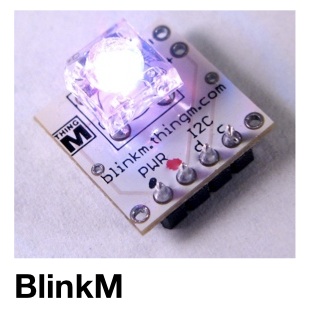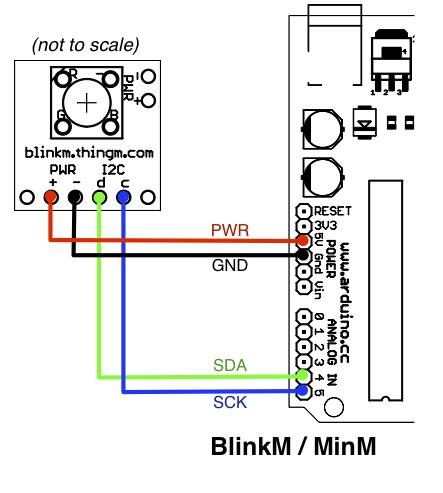| |
BlinkM Tutorial
Description: Control a BlinkM through ROS using an Arduino and rosserialTutorial Level: ADVANCED
Next Tutorial: Arduino Oscilloscope
Show EOL distros:
One thing every robot needs is a good indicator light. If you are looking for something more fancy or just plane brighter than just a single tiny LED, the BlinkM is a good choice for your robotics project. The BlinkM is a I2C controlled multi-colored LED which can change colors and run lighting scripts. In this tutorial, we are going to use the default scripts of a BlinkM to create a multicolored blinking or solid indicator light.

For this tutorial, you will be using the example provided with ros_lib. In your Arduino IDE, go to File>Examples>ros_lib>BlinkM. The code can also be found in rosserial_arduino/src/ros_lib/examples.
For a full reference and getting started guide for the BlinkM, see the BlinkM datasheet.
Hardware

Diagram from the BlinkM datasheet
The hardware for this tutorial is relatively simple. All that is neccesary is a BlinkM and an Arduino. The BlinkM needs to be connected to 5V, GND, and the Arduino's I2C connections (SDA and SCL). You can purchase both a BlinkM and an Arduino from Sparkfun.
Code
The ROS serial integration code for the blinkm is below. In this arduino sketch, the node subscribes to a std_msgs/String on the blinkm topic. In the callback, the the node parses the command to determine the LED's color and if it should be blinking. The LED can be red (r), blue (b), magenta(m), green(g), white(w), cyan(c), and yellow(y). If the command begins with an 'S' or 's' the LED is a solid color. Otherwise, the LED blinks that color.
1 /*
2 * RosSerial BlinkM Example
3 * This program shows how to control a blinkm
4 * from an arduino using RosSerial
5 */
6
7 #include "WProgram.h" //include the Arduino library
8 #include <stdlib.h>
9
10
11 #include <ros.h>
12 #include <std_msgs/String.h>
13
14
15 //include Wire/ twi for the BlinkM
16 #include <Wire.h>
17 extern "C" {
18 #include "utility/twi.h"
19 }
20
21 #include "BlinkM_funcs.h"
22 const byte blinkm_addr = 0x09; //default blinkm address
23
24
25 void setLED( bool solid, char color)
26 {
27
28 if (solid)
29 {
30 switch (color)
31 {
32
33 case 'w': // white
34 BlinkM_stopScript( blinkm_addr );
35 BlinkM_fadeToRGB( blinkm_addr, 0xff,0xff,0xff);
36 break;
37
38 case 'r': //RED
39 BlinkM_stopScript( blinkm_addr );
40 BlinkM_fadeToRGB( blinkm_addr, 0xff,0,0);
41 break;
42
43 case 'g':// Green
44 BlinkM_stopScript( blinkm_addr );
45 BlinkM_fadeToRGB( blinkm_addr, 0,0xff,0);
46 break;
47
48 case 'b':// Blue
49 BlinkM_stopScript( blinkm_addr );
50 BlinkM_fadeToRGB( blinkm_addr, 0,0,0xff);
51 break;
52
53 case 'c':// Cyan
54 BlinkM_stopScript( blinkm_addr );
55 BlinkM_fadeToRGB( blinkm_addr, 0,0xff,0xff);
56 break;
57
58 case 'm': // Magenta
59 BlinkM_stopScript( blinkm_addr );
60 BlinkM_fadeToRGB( blinkm_addr, 0xff,0,0xff);
61 break;
62
63 case 'y': // yellow
64 BlinkM_stopScript( blinkm_addr );
65 BlinkM_fadeToRGB( blinkm_addr, 0xff,0xff,0);
66 break;
67
68 default: // Black
69 BlinkM_stopScript( blinkm_addr );
70 BlinkM_fadeToRGB( blinkm_addr, 0,0,0);
71 break;
72 }
73 }
74
75
76 else
77 {
78 switch (color)
79 {
80 case 'r': // Blink Red
81 BlinkM_stopScript( blinkm_addr );
82 BlinkM_playScript( blinkm_addr, 3,0,0 );
83 break;
84 case 'w': // Blink white
85 BlinkM_stopScript( blinkm_addr );
86 BlinkM_playScript( blinkm_addr, 2,0,0 );
87 break;
88 case 'g': // Blink Green
89 BlinkM_stopScript( blinkm_addr );
90 BlinkM_playScript( blinkm_addr, 4,0,0 );
91 break;
92
93 case 'b': // Blink Blue
94 BlinkM_stopScript( blinkm_addr );
95 BlinkM_playScript( blinkm_addr, 5,0,0 );
96 break;
97
98 case 'c': //Blink Cyan
99 BlinkM_stopScript( blinkm_addr );
100 BlinkM_playScript( blinkm_addr, 6,0,0 );
101 break;
102
103 case 'm': //Blink Magenta
104 BlinkM_stopScript( blinkm_addr );
105 BlinkM_playScript( blinkm_addr, 7,0,0 );
106 break;
107
108 case 'y': //Blink Yellow
109 BlinkM_stopScript( blinkm_addr );
110 BlinkM_playScript( blinkm_addr, 8,0,0 );
111 break;
112
113 default: //OFF
114 BlinkM_stopScript( blinkm_addr );
115 BlinkM_playScript( blinkm_addr, 9,0,0 );
116 break;
117 }
118
119 }
120 }
121
122 void light_cb( const std_msgs::String& light_cmd){
123 bool solid =false;
124 char color;
125 if (strlen( (const char* ) light_cmd.data) ==2 ){
126 solid = (light_cmd.data[0] == 'S') || (light_cmd.data[0] == 's');
127 color = light_cmd.data[1];
128 }
129 else{
130 solid= false;
131 color = light_cmd.data[0];
132 }
133
134 setLED(solid, color);
135 }
136
137
138
139 ros::NodeHandle nh;
140 ros::Subscriber<std_msgs::String> sub("blinkm" , light_cb);
141
142
143 void setup()
144 {
145
146 pinMode(13, OUTPUT); //set up the LED
147
148 BlinkM_beginWithPower();
149 delay(100);
150 BlinkM_stopScript(blinkm_addr); // turn off startup script
151 setLED(false, 0); //turn off the led
152
153 nh.initNode();
154 nh.subscribe(sub);
155
156 }
157
158 void loop()
159 {
160 nh.spinOnce();
161 delay(1);
162 }
Another key feature of this script that should be noted is that the I2C address of the BlinkM is set to the default BlinkM I2C. If yours has been reprogrammed, or if you want to control multiple BlinkMs, you will need to change this address.
Testing
Program you Arduino with the BlinkM sketch. Open the blinkm sketch from the package://roserial_arduino_tutorials/sketches/BlinkM folder and program your Arduino.
Start up the roscore in a new termianl
roscore
Launch the rosserial_python serial_node. Make sure to choose the right serial port.
rosrun rosserial_python serial_node.py _port:=/dev/ttyUSB0
rosrun rosserial_python serial_node.py /dev/ttyUSB0
Now, look at the red blinking light!
rostopic pub blinkm std_msgs/String "br"
Blue light!
rostopic pub blinkm std_msgs/String "sb"







